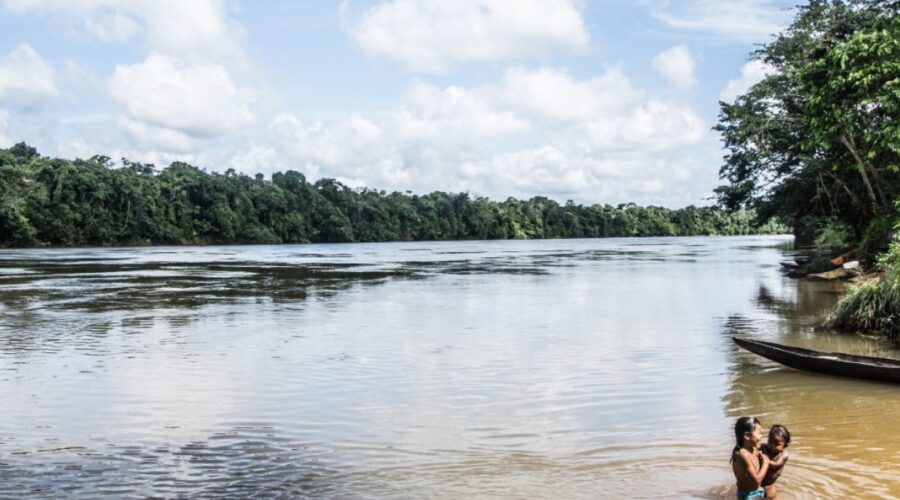In 2019, an alarming rate of rainforest loss put the Amazon region into the global spotlight. The destruction of the world’s lungs threatens humanity because it contributes to global warming, diminishes biodiversity, and puts the rights of future generations at risk. The Covid-19 crisis is a relevant opportunity to analyze the immediate social impacts of deforestation. And more specifically, how the pandemic has made more evident the vulnerability of the local communities in the regions where deforestation takes place. In this article, I will analyze the case of the Colombian Amazon.
Understanding Covid-19 in the Colombian context
The Colombian Amazon region consists of six territorial departments and covers about 40 percent of the country’s territory.[1] It is strategically located, bordering Brazil, Ecuador, Peru, and Venezuela. The Colombian State has historically been absent in this important area of the country. For this reason, the first report of a Covid-19 patient on April 17th set off major alarms: the Amazon region lacks the minimum sanitary conditions necessary to cope with the pandemic.
According to the figures of the last national census, the rate of multidimensional poverty in rural areas of the Colombian Amazon is 53.1 percent (compared to the national rate of 19.6 percent). Some of the main challenges faced by the people of the Orinoco-Amazon region are informal work (87.5 percent), lack of access to improved water sources (30 percent), and critical overcrowding (13.5 percent).[2]
Under these conditions, the measures of isolation and self-protection that have been implemented in other contexts do not work. If people live in houses that do not meet the minimum sanitary conditions and need to get to the streets to find their food and income, the effectiveness of the lockdown can be called into question. As in the case of Afghanistan, discussed earlier in this blog series, Covid-19 represents a crisis among many other crises in the Colombian Amazon.
Furthermore, the State’s capacity to control transboundary movements is minimal. Consequently, measures to prevent the spread of the virus between countries (especially in Brazil) were not applied in time, increasing the risk of infection. Leticia represents the most critical example of this situation. As the capital of the Amazon province, Leticia is experiencing one of the worst tragedies in its history due to Covid-19. The city suffers from the highest rate of infection per inhabitant in Colombia. With a population of 42,844 people, Leticia has reported 1,810 cases of Covid-19. The city does not have a single intensive care bed installed to treat the people who require critical medical care, further exacerbating the dire situation.
As Leticia is situated on the border between Colombia and Brazil, the division with the Brazilian city of Tabatinga exists only in theory. People move from one country to the other to buy their food, work or spend time with their loved ones. Because Brazil’s president, Jair Bolsonaro, is vehemently denying the seriousness of the pandemic, brushing aside the need to adopt epidemiological measures, the high level of connectivity between Leticia and Tabatinga augmented the transmission risk into Colombia.
Now, let’s add deforestation to the mix
At first sight, it may seem that rural communities are less at risk of Covid-19 since they are less exposed to overcrowded spaces. However, deforestation adds another level of complexity and poses considerable challenges for rural communities to overcome. Forced displacement, health problems, and water pollution due to illegal mining and forest loss jeopardize public health in Amazonian rural communities, heightening the risk of Covid-19 infection.
Worsening matters still, deforestation in the Colombian Amazon has also increased during the pandemic. According to a recent article published in PID Amazonia, the agents of deforestation have not been in quarantine. These culprits are taking advantage of the health crisis and the shift in public focus to continue destroying important natural protected areas, including regions within the Natural Park Chiribiquete.
According to data from IDEAM, in March 2020, there were four times as many forest fires as in the previous year. In this sense, Colombia’s forests continue to burn, following the trend in Brazil and Bolivia, which was analyzed earlier in this blog series. Similarly, a study published by WWF reported that in March 2020, deforestation in Argentina, Colombia, and Peru increased by about 400 percent compared to previous years. The same study also highlights how unemployment is putting forests at an increased risk of deforestation.
Why does this peak in deforestation worsen the situation for indigenous peoples?
The very tragic case of the Nukak community illustrates how the overlap between Covid-19 and deforestation endangers indigenous communities. The Nukak people are one of the few nomadic communities left in Latin America. They are hunters, fishermen, and gatherers, but the destruction of their territory has drastically changed their way of life, and the risk of their extinction is imminent.
The Nukak people had their first contact with outsiders in the first half of the 20th century. At the time, settlers from different regions of the country arrived at the Amazon during the rubber boom, invaded Nukak territory, and forced them to work under conditions of slavery. This contact with outsiders has appalling effects. Their immune systems did not have the mechanisms to resist certain diseases, and their population diminished considerably because of illnesses such as the flu or malaria. According to the last national census, there are only 744 indigenous Nukak left in Colombia (30 percent less than in 2005).
Currently, the survival of the Nukaks and their right to live on their land is threatened by actors of drug trafficking, large livestock farms, and illegal industries of palm oil and eucalyptus. As a result of the rise in fires during the lockdown, Nukak members are increasingly forced to leave their ancestral territory and move out to cities like San José del Guaviare. Semana Sostenible warned that their situation in this city is very critical: “Several [Nukak] are literally eating food from garbage dumps”.
Protecting this Indigenous community should be high on the government’s priority list. The Nukak are being displaced from their ancestral lands, their immune systems are already compromised, they do not have access to clean water sources or basic sanitation, and the health sector infrastructure in the Amazon region is unable to accommodate them.
The measures implemented in urban contexts to protect populations at risk do not seem to be the best option in this case. The Nukak cannot stay at home; they are escaping from those who are destroying and invading the forest. The Nukak cannot wash their hands regularly either, as they do not have access to improved water systems.
The tragedy of the Nukak shows that when the forests are cut down, the survival of ancestral communities is also put at risk. In the current context, the safest option for indigenous groups would be to shelter in their territory. However, forest areas are becoming smaller and smaller, which also affects the right of communities to food sovereignty. Paradoxically, in one of the richest areas in terms of natural resources, local communities are facing situations such as a decrease in fish and the depletion of soil nutrients needed for planting.
Halting deforestation is essential
The pandemic reveals that halting deforestation is crucial. Not only does deforestation impact technical indicators such as greenhouse gas emissions, air quality, or loss of forest cover, but it also – and most importantly – directly affects the living conditions of ancestral communities.
As Elver Viena, leader of the Uitoto ethnic group points out regarding the unfulfilled promise of the governments of the region to protect the Amazon: “They are committed to protecting biodiversity, but they must be reminded that biodiversity is also the indigenous peoples.” I use his message to remind those of us who work in the environmental sector that our work cannot ignore the social dimension of the ecological crisis that we are living in. Thus, we must be key allies in supporting communities in the struggle to preserve their territories and culture. The best way to protect the forest is to promote sustainable and safe conditions for the legitimate guardians of the forest to thrive.
Footnotes:
[1] The six departments are: Amazonas, Caquetá, Guainía, Guaviare, Putumayo, and Vaupés.
[2] According to the definitions of the Colombian Multidimensional Poverty Index, a person lives in critical overcrowding when he/she lives in a house containing more than three people per room.


